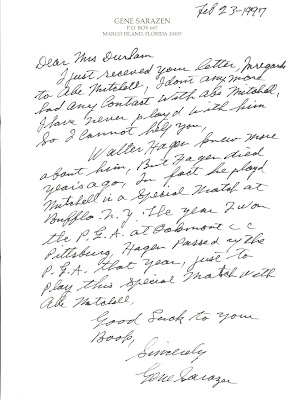"Walter Hagen is a good golfer, but he is also a master of the gentle art of making the English thoroughly dislike him."
Topics of the Times, June 28, 1926
Golf Illustrated, July 1926
"The only blot on the day was Hagen's late arrival on the second day when he kept Mitchell waiting 25 minutes before he appeared on the first tee. It is a very great pleasure for British golfers, and a stimulant to the game, that leading American professionals visit this country every year, but we feel that, in the general interest, they ought to observe starting times."
NY Times, Edwin James
"Not only do our political representatives scatter the earth with the posies of our good advice, but now our golf ambassador Walter Hagen has told the English what is wrong with how they play golf: "They like sportsmanship better than winning," he said. "British pros are misguided beings who play golf just for the fun of it. "
"It aggravates me when, after I have beaten some Englishman, some one says that the Englishman was a good sport. Sure he was a good sport, but what's the use of coming over here to play among ourselves? We can do that at home, but what he ought to be is a good golfer. I don't believe American golfers will come back for a few years. "
It was not a good time to needle the British about their golf games. What followed was a low point in golf history. The R&A abruptly set their 1927 Open date to conflict with the US Open date, a matter that had been informally agreed upon during a collegial meeting with USGA President William C. Fownes, Jr. only weeks before. What followed was untidy and if left unresolved, would have been a shambles. (Note: It was Fownes, in 1921, who gathered an American team and sailed for England to play the inaugural Walker Cup match, because war-weary Britain was unable to accept its invitation to play in the USA.)
It was not a good time to needle the British about their golf games. What followed was a low point in golf history. The R&A abruptly set their 1927 Open date to conflict with the US Open date, a matter that had been informally agreed upon during a collegial meeting with USGA President William C. Fownes, Jr. only weeks before. What followed was untidy and if left unresolved, would have been a shambles. (Note: It was Fownes, in 1921, who gathered an American team and sailed for England to play the inaugural Walker Cup match, because war-weary Britain was unable to accept its invitation to play in the USA.)
Sunday Observer, London
NY Times
"USGA Not Consulted After
Cooperation Had Been Promised."
"Ruling bodies are at loggerheads on what is a simple and trivial point. Both desire to hold their respective championships at about the same time and neither is willing to give way. It has all the appearance of a childish quarrel."NY Times
"As America captured the British championship five times in the last six years, it is perhaps as well for the dignity of British golf that next year there are to be no Americans competing."
Sunday Observer (London)
 |
The threat to Ryder Cup plans that this episode created may have alerted Sam to an uncertain future for his Cup and may be the reason why the following item was included in the Deed of Trust: "If at any time the Committee of the PGA of GB pass a resolution saying that in their opinion no good purpose is served by continuing the said competitions it will be lawful in their absolute discretion to award the Cup either alone or with other prizes by the said Association within Great Britain."
~~~~~~~~~~~~~~~~~~
What on earth was Hagen thinking? Perhaps the answer lay in the fact that, like Abe, Walter grew up near a golf course for toffs. The farmhouse where he was born perched on a hillside overlooking Corbett's Glen, a setting so unusual that it may have affected young Walter's reason. The front of his house faced the road while the back faced Allens Creek. Both the road and the creek descended the hill to form a V at the bottom where rapids shot under a small bridge. The water then turned sharply parallel to the road so that the V became a Y as it swept over a ten foot falls in an explosion of sound. Together, road and creek proceeded sedately side by side through a spectacular stone archway on top of which, at intervals, the thundering traffic of the main line of the New York Central Railroad pounded overhead through Corbett's Glen. At the opposite end of the long tunnel the road and the creek went their separate ways. It was noisy and exciting and above all confusing, and clearly proves that if enough structure surrounds a problem, people will forget what the problem was in the first place.
Sanity Prevails
William Richardson, NY Times, January 5 1927 :
"The clash between the USGA and R&A is over. As a result of a compromise it is expected that plans for sending a British team of professionals to this side for a team match will proceed and that this year's open championship will have the greatest international flavor in its history."
.JPG)





















